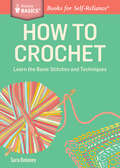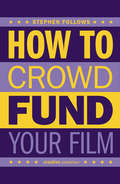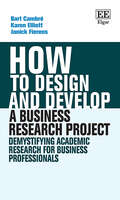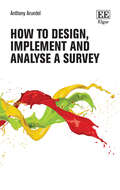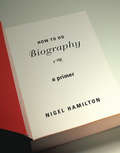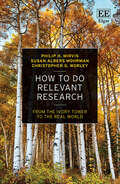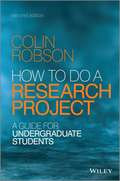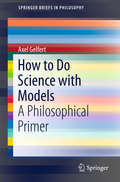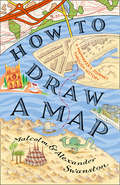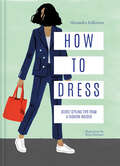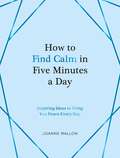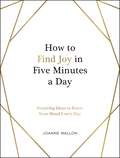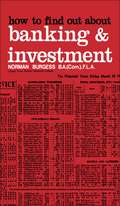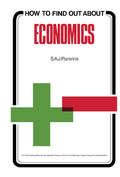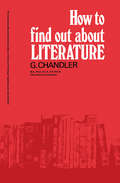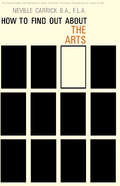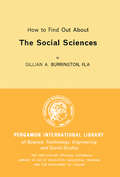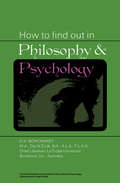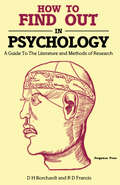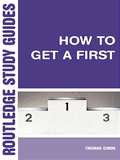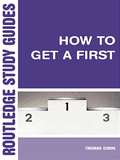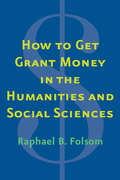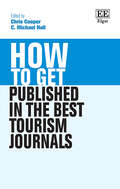- Table View
- List View
How to Crochet: Learn the Basic Stitches and Techniques. A Storey BASICS® Title (Storey Basics)
by Sara DelaneyThis fun introduction to crocheting presents all the basic techniques you&’ll need to get started.
How to Crowdfund Your Film: Tips and Strategies for Filmmakers
by Stephen FollowsCrowdfunding is a major source of funding for independent films and over $250 million has been raised for films just on Kickstarter alone. This book will guide you through every stage of planning, creating and running your film crowdfunding campaign.This book is based on extensive data research and interviews which include:Data research on over 50,000 film crowdfunding campaignsInterviews with over 50 filmmakers who have run crowdfunding campaignsInterviews with some of the top people at major crowdfunding platforms and servicesPraise for Stephen Follows'Stephen drills down on data to discover truths about the film industry. Totally worth a read' - Ted Hope, Head of Production, Amazon Original Movies'Stephen's research is brilliant. No-one is doing data-driven analysis of the film industry quite like Stephen Follows. His detailed research and reporting about the film industry is unique and invaluable' - Jonathan Wolf, Head of The American Film Market'Stephen is one of the most gifted producers I know. His mind operates at an entirely different speed to almost everyone I know, solving problems, offering solutions and innovating new opportunities at breakneck speed' - Chris Jones, author of The Guerrilla Filmmakers HandbookPlease note that this is a fixed-format ebook file.
How to Design and Develop a Business Research Project: Demystifying Academic Research for Business Professionals (How To Guides)
by Bart Cambré Karen Elliott Janick FierensThrough a fascinating exploration of the advantages and pitfalls of business research methods, this essential book encourages the reader to make well-informed decisions in an often fast-paced environment. It sets out key rules and procedures to ultimately improve the accuracy and authenticity of research ventures.Providing crucial insight from highly regarded business professionals, this innovative book offers an illustrative guide to aid practitioners in the following:Designing and evaluating business research on its reliability, validity, and rigour.Understanding the utilization of data and digital technologies in research projects.Fully grasping research terminology and employing a succinct research template in practical contexts.How to Design and Develop a Business Research Project will be vital for business and management professionals seeking to further develop strategies and collaborative research skills within the sector. It will additionally be highly beneficial for academics striving to grasp the context and mindset of business and management research.
How to Design, Implement, and Analyse a Survey (How to Research Guides)
by Anthony ArundelThis insightful book examines all aspects of the design process and implementation of questionnaire surveys on the activities of business, public sector, and non-profit organizations. Anthony Arundel discusses how different aspects of the survey method and planned statistical analysis can constrain question design, and how these issues can be effectively resolved. Throughout this engaging yet practical book, Arundel promotes good practices for questionnaire design, sample construction, and survey delivery systems including online, postal, and verbal methods, with a focus on obtaining high-quality data in line with ethics and confidentiality requirements. Chapters include constructive advice on questionnaire design and testing, survey implementation, and data processing, analysis, and reporting, with examples of time and financial cost budgets. Considering the recent developments in survey methods, the book explores how to use web probing as a substitute for cognitive testing and examines the use of tablets and smartphones in answering questionnaires. Combining theoretical and practical insights into survey design, implementation, and data processing and analysis, this book will be essential reading for business and management scholars and students, with a particular interest in research methods and organization studies. It will also be useful for practitioners and business managers seeking to understand how to create and use surveys.
How To Do Biography: A Primer
by Nigel HamiltonIt is not surprising that biography is one of the most popular literary genres of our day. What is remarkable is that there is no accessible guide for how to write one. Now, following his recent Biography: A Brief History (from Harvard), award-winning biographer and teacher Nigel Hamilton tackles the practicalities of doing biography in this first succinct primer to elucidate the tools of the biographer’s craft. Hamilton invites the reader to join him on a fascinating journey through the art of biographical composition. Starting with personal motivation, he charts the making of a modern biography from the inside: from conception to fulfillment. He emphasizes the need to know one’s audience, rehearses the excitement and perils of modern research, delves into the secrets of good and great biography, and guides the reader through the essential components of life narrative. With examples taken from the finest modern biographies, Hamilton shows how to portray the ages of man—birth, childhood, love, life’s work, the evening of life, and death. In addition, he suggests effective ways to start and close a life story. He clarifies the difference between autobiography and memoir—and addresses the sometimes awkward ethical, legal, and personal consequences of truth-telling in modern life writing. He concludes with the publication and reception of biography—its afterlife, so to speak. Written with humor, insight, and compassion, How To Do Biography is the manual that would-be biographers have long been awaiting.
How to Do Relevant Research: From the Ivory Tower to the Real World
by Christopher G. Worley Philip H. Mirvis Susan Albers MohrmanAmidst rapid and fundamental shifts in the economic, geo-political, technological, and societal landscape, this cutting-edge book makes the timeless case that research can be informed by problems in the 'real world' and make important contributions to theory and practice.Throughout the book, the authors argue that there is a 'sweet spot' where both scholarly and practical research can be done simultaneously. It offers readers insightful and rich examples of how this can be achieved, including frameworks, examples, ideas, and tools which will guide researchers in the lifelong task of defining themselves as researchers and crafting their own unique research practice. It also features critical insights into careers oriented toward having impact on practice, reflective questions that make the principles personal and relevant, and a framework to help develop the network of connections required for research to impact practice.Speaking to the graduate student in all of us, How to Do Relevant Research will greatly benefit Ph.D. students and early career academics who gravitate towards this kind of research but worry about its feasibility and instrumentality, mid-to-late career scholars who do research for practice and teach young scholars how to do it, and to researchers in a think-tank or consultancy who want their work to be scientifically sound and practically useful.
How To Do A Research Project 2E - A Guide For Undergraduate Students
by Colin RobsonWritten specifically to address the needs and concerns of the undergraduate, this tightly focused second edition guides students through the process of conducting and completing a research project. Friendly and accessible, this fully-updated second edition includes a number of accompanying student support materials to aid students further. Closely integrated sets of end-of-chapter tasks covering all aspects of research projects from design to completion, as well as suggested further reading, enhance each chapter. A wide range of additional helpful materials relevant to particular subject areas is also available on the accompanying website at www. wiley. com/college/robson. This textbook is an invaluable resource for students in a wide range of disciplines and fields of study, particularly those planning to use social research methods or to carry out a library-based study, for their undergraduate research project.
How to Do Science with Models: A Philosophical Primer (SpringerBriefs in Philosophy #0)
by Axel GelfertTaking scientific practice as its starting point, this book charts the complex territory of models used in science. It examines what scientific models are and what their function is. Reliance on models is pervasive in science, and scientists often need to construct models in order to explain or predict anything of interest at all. The diversity of kinds of models one finds in science – ranging from toy models and scale models to theoretical and mathematical models – has attracted attention not only from scientists, but also from philosophers, sociologists, and historians of science. This has given rise to a wide variety of case studies that look at the different uses to which models have been put in specific scientific contexts. By exploring current debates on the use and building of models via cutting-edge examples drawn from physics and biology, the book provides broad insight into the methodology of modelling in the natural sciences. It pairs specific arguments with introductory material relating to the ontology and the function of models, and provides some historical context to the debates as well as a sketch of general positions in the philosophy of scientific models in the process.
How to Draw a Map
by Malcolm Swanston Alex SwanstonHow to Draw a Map is a fascinating meditation on the centuries-old art of map-making, from the first astronomical maps to the sophisticated GPS guides of today.
How to Dress: Secret Styling Tips From A Fashion Insider
by Alexandra FullertonThe perfect book for anyone who wants to know the secrets to always looking stylish with minimal effort.
How to Find Calm in Five Minutes a Day: Inspiring Ideas to Bring You Peace Every Day
by Joanne MallonThis book includes over 60 prompts and ideas to help you pause for peace and connect to calm every single day - and each tip takes no longer than five minutes Pockets of calm are all around us, even on the busiest of days - and they're easy to find when you know where to look. All you need is five minutes. Guiding you through each stage of your day, these soothing rituals will help you to recentre yourself and rise above everyday stresses. Tips include:- How to incorporate mindfulness into your routine- Starting the day with a relaxation exercise and a calming mantra- Visualizing what calm looks like to you- Writing down your worries to gain focus and perspectiveEven the smallest moment of calm can transform your outlook, so whether you follow one tip or many, you're sure to de-stress, boost your well-being and find clarity and calm every day.
How to Find Joy in Five Minutes a Day: Inspiring Ideas to Boost Your Mood Every Day
by Joanne MallonJoy is all around us. It’s in the first sip of a cup of tea, the beauty of a sunrise, or the simple pleasure of a deep breath, and it’s easy to find when you know where to look. All you need is five minutes. This book includes over 60 prompts and ideas to help you to find joy every single day. Taking you through your morning, your afternoon and your evening, these tips will help you to elevate your mood and liven up your routine – and each one takes no longer than five minutes.Tips include:Setting an intention for your dayPerforming a small act of kindnessEating outdoors in the fresh airTrying a grounding ritualEven the smallest moment of positivity can transform your outlook, so whether you follow one tip or many, you’re sure to lift your spirits and find a small oasis of happiness every day.
How to Find Out About Banking and Investment: The Commonwealth and International Library: Libraries and Technical Information Division
by Norman BurgessHow to Find Out About Banking and Investment focuses on the sources of information on banking and investment. The publication first ponders on careers, dictionaries and encyclopedias, and libraries and guides to libraries. Discussions focus on guides to the resources of libraries, Banking Information Service, Bank Education Service, education and examinations in America, sources of information on careers, finance houses, joint stock banking, foreign and merchant banks, and the London Stock Exchange. The text then takes a look at bibliographies and literature guides, periodical literature, financial economics, banks and banking, and central banking classification. Topics include library catalogues, guides to reference works, periodicals concerned with banking and finance, money and banking in the United States, financial institutions and economic development, banking in Europe, European Economic Community, and banking in the United States. The book takes a look at interest and discount, credit and instruments of credit, foreign and overseas investment, and merchant and investment banking.The publication is a dependable source of information for researchers and bankers wanting to explore banking and investment.
How to Find Out About Economics: The Commonwealth and International Library: Libraries and Technical Information Division
by S. A. ParsonsHow to Find Out About Economics focuses on information sources related to economics, including books, periodicals, government publications, and national and international organizations. The sources of arranged according to the Dewey Decimal Classification used by many libraries. This book is comprised of 17 chapters and begins with an overview of modern economics and guides to careers in economics. The following chapters focus on sources of employment registers and careers advice in economics; career and vocational guidance in the United States; and career patterns for economists. The discussion then turns to two categories of information relating to economics: bibliographical sources such as books, periodicals, abstracts, and similar printed documents; and non-bibliographical sources such as organizations and societies formed, for example, by economists or persons having an interest in economics. The book also considers libraries and their functions; guides to library resources; sources of education for careers in economics; and sources of economic history, business history, and biography. This monograph will be a useful resource for students and others interested in embarking on a career in economics.
How to Find Out About Literature
by G. ChandlerHow to Find Out About Literature aims to provide a general survey of literatures and a general indication of the dates of these literatures. The book first elaborates on how to study and appreciate literature and how to trace literary works, including exercises and universal and national bibliographies. The text then examines how to trace poetry, drama, novels, and prose, foreign and subject bibliographies, library and sale catalogues, and guides to libraries, and literary information on general reference books and encyclopedias. The manuscript discusses how to trace literary information in handbooks and concordances to poetry and drama, handbooks and reference books on novelists and prose writers, dictionaries and guides to the English language and specialized subjects, essays, theses, and periodical articles. The text ponders on how to trace periodical articles and literary abstracts. The book is a valuable reference for students and researchers in their studies.
How to Find Out About the Arts: A Guide to Sources of Information
by Neville CarrickHow to Find Out About the Arts: A Guide to Sources of Information discusses the main sources of information, printed or otherwise, in the field of the arts. The book begins by describing where information on art careers can be found. Separate chapters then discuss how information on art can be traced in libraries by means of the catalogue and classification scheme; and turning to bibliographies when information on a particular aspect of art cannot be traced by these means. Subsequent chapters deal with sources such as encyclopedias and dictionaries, general indexes to reproductions and portraits, works on iconography, periodicals, directories, yearbooks, and sales records. This book aims to serve some of the needs of the student of art, the experienced artist, and indeed all of those with an intelligent interest in the arts. In particular, it should help those in libraries, colleges, and other educational institutions whose task it is to guide others to the right sources.
How to Find Out About the Social Sciences: Library and Technical Information
by Gillian A. BurringtonHow to Find Out About The Social Sciences indicates the sources of information in the social sciences that are traditionally taught in social science faculties in universities. The book delineates the scope and nature of the different social sciences, explains the necessary education and training, and lists possible careers for those who take up the studies. The book also lists the possible sources of information such as organizations, libraries, books and other published material, and social administration. Lastly, it explains the significance of the different sources of information, what kind of information could be derived from them, and how they can be used to learn or teach in the social sciences. The text is for social scientists, professors, and researchers on the discipline and its many branches. It is also recommended for undergraduate and graduate students alike, as well as those who have taken a casual interest on the social sciences.
How to Find Out About the Victorian Period: A Guide to Sources of Information
by Lionel MaddenHow to Find Out About the Victorian Period: A Guide to Sources of Information focuses on the Victorian period of Great Britain. The book first discusses the study of the Victorian period and general guides to the literature. The use of books, periodical articles, theses, and bibliographies in the study of this period in British history is emphasized. The text underscores the value of Victorian periodicals and newspapers in the study of the Victorian period. Guides to special collections and source materials on this period are discussed. These include guides to collection of books and manuscripts, libraries and their collections, archives and manuscripts, and government publications. The book also presents guides to the study of the Victorian church. These include encyclopedias and dictionaries, biographical works, and theses. Guides on the kind of education, development of science, visual arts, music, and literature of the Victorian period are also described. The text is a fine reference for readers who are interested in British history, particularly the Victorian era.
How to Find Out in Philosophy and Psychology: The Commonwealth and International Library: Library and Technical Information Division
by D. H. BorchardtHow to Find Out in Philosophy and Psychology is a guidebook for accessing various philosophical and psychological literatures. The coverage of the text includes dictionaries, journals, encyclopedias, and handbooks. The selection also covers various kinds of bibliographies, such as national, general retrospective, and bibliographies of specialized fields. The last chapter tackles various philosophical and psychological organizations. The book will be of great use to students who needs to have access to various philosophical and psychological materials.
How to Find Out in Psychology: A Guide to the Literature and Methods of Research
by D. H. Borchardt R. D. FrancisHow to Find Out in Psychology: A Guide to the Literature and Methods of Research is a research guidebook in psychology. The book is comprised of 11 chapters that address concerns in psychological research. The text first covers the concept of psychology and its major theories, and then proceeds to tackling bibliographic aids for research in psychology. The next series of chapters details the methodologies in researching and presenting. The last chapters discuss the professional matters in psychology. The book will be of great use to students, researchers, and practitioners of behavioral science.
How to Get a First: The Essential Guide to Academic Success
by Thomas DixonIn this informative guide, Thomas Dixon argues that you do not have to be a genius to get a first at university. He sets out to de-mystify first-class degrees in the arts, humanities and social sciences, clearly articulating the difference between the excellent and the merely competent in undergraduate work. This concise, no-nonsense guidebook will give prospective and current students advice on teaching and learning styles that prevail in university and on how to manage their two most important resources - their time and their lecturers. In an accessible and entertaining style, the author looks at subjects such as: making the transition from school to university developing transferable skills making use of lectures and seminars using libraries and the Internet note-taking, essays, seminars and presentations common mistakes to avoid writing with clarity and style revision and examinations. Illustrated with many examples from a range of academic disciplines, How to Get a First is an all-purpose guide to success in academic life. Visit the companion website www.getafirst.com
How to Get a First: The Essential Guide to Academic Success
by Thomas DixonIn this informative guide, Thomas Dixon argues that you do not have to be a genius to get a first at university. He sets out to de-mystify first-class degrees in the arts, humanities and social sciences, clearly articulating the difference between the excellent and the merely competent in undergraduate work. This concise, no-nonsense guidebook will give prospective and current students advice on teaching and learning styles that prevail in university and on how to manage their two most important resources - their time and their lecturers. In an accessible and entertaining style, the author looks at subjects such as: making the transition from school to university developing transferable skills making use of lectures and seminars using libraries and the Internet note-taking, essays, seminars and presentations common mistakes to avoid writing with clarity and style revision and examinations. Illustrated with many examples from a range of academic disciplines, How to Get a First is an all-purpose guide to success in academic life. Visit the companion website www.getafirst.com
How To Get A First: The Essential Guide To Academic Success (PDF)
by Thomas DixonIn this informative guide, Thomas Dixon argues that you do not have to be a genius to get a first at university. He sets out to de-mystify first-class degrees in the arts, humanities and social sciences, clearly articulating the difference between the excellent and the merely competent in undergraduate work. This concise, no-nonsense guidebook will give prospective and current students advice on teaching and learning styles that prevail in university and on how to manage their two most important resources - their time and their lecturers. In an accessible and entertaining style, the author looks at subjects such as: making the transition from school to university developing transferable skills making use of lectures and seminars using libraries and the Internet note-taking, essays, seminars and presentations common mistakes to avoid writing with clarity and style revision and examinations. Illustrated with many examples from a range of academic disciplines, How to Get a First is an all-purpose guide to success in academic life. Visit the companion website www. getafirst. com
How to Get Grant Money in the Humanities and Social Sciences
by Raphael Brewster FolsomA valuable and engaging guide to applying for—and getting—grants in the humanities and social sciences Scholars in the humanities and social sciences need money to do research. This book shows them how to get it. In this accessible volume, Raphael Folsom shares proven strategies in a series of short, witty chapters. It features tips on how graduate students, postdocs, and young faculty members can present themselves and their work in the best possible light. The book covers the basics of the grant-writing process, including finding a mentor, organizing a writing workshop, conceptualizing the project on a larger scale, and tailoring an application for specific submissions. The book includes interviews with nine of the most respected scholars in the country, each of whom has evaluated thousands of grant applications. The first authoritative book on the subject, Folsom's indispensable work will become a must-have resource for years to come.
How to Get Published in the Best Tourism Journals (How To Guides)
Drawing on a wealth of knowledge and experience from leading tourism academics and journal editors, this practical How To guide offers clear-sighted advice on how to craft a high-quality paper in terms of contribution, positioning and submission. Accessible and comprehensive, it demystifies the process of getting published in the top tourism journals.This insightful book begins by mapping out the tourism publishing landscape, before delving into the various methods of building a refereed journal paper and navigating tourism publishers. Chapters dissect contemporary publishing issues, including gender inequality, ethics and integrity, and the dominance of English language publishing. Finally, contributors outline the essential role of publishing in shaping an academic career in tourism, especially in securing jobs, obtaining grant funding and creating pathways for career progression.How to Get Published in the Best Tourism Journals offers an insider perspective and practical advice while posing questions about the future of tourism publishing in the light of developments such as AI and Open Access. It will prove an essential resource to enhance journal publication success for tourism PhD students, as well as tourism academics at all career stages.
